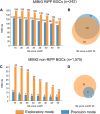RRE-Finder: a Genome-Mining Tool for Class-Independent RiPP Discovery
- PMID: 32873609
- PMCID: PMC7470986
- DOI: 10.1128/mSystems.00267-20
RRE-Finder: a Genome-Mining Tool for Class-Independent RiPP Discovery
Abstract
Many ribosomally synthesized and posttranslationally modified peptide classes (RiPPs) are reliant on a domain called the RiPP recognition element (RRE). The RRE binds specifically to a precursor peptide and directs the posttranslational modification enzymes to their substrates. Given its prevalence across various types of RiPP biosynthetic gene clusters (BGCs), the RRE could theoretically be used as a bioinformatic handle to identify novel classes of RiPPs. In addition, due to the high affinity and specificity of most RRE-precursor peptide complexes, a thorough understanding of the RRE domain could be exploited for biotechnological applications. However, sequence divergence of RREs across RiPP classes has precluded automated identification based solely on sequence similarity. Here, we introduce RRE-Finder, a new tool for identifying RRE domains with high sensitivity. RRE-Finder can be used in precision mode to confidently identify RREs in a class-specific manner or in exploratory mode to assist in the discovery of novel RiPP classes. RRE-Finder operating in precision mode on the UniProtKB protein database retrieved ∼25,000 high-confidence RREs spanning all characterized RRE-dependent RiPP classes, as well as several yet-uncharacterized RiPP classes that require future experimental confirmation. Finally, RRE-Finder was used in precision mode to explore a possible evolutionary origin of the RRE domain. The results suggest RREs originated from a co-opted DNA-binding transcriptional regulator domain. Altogether, RRE-Finder provides a powerful new method to probe RiPP biosynthetic diversity and delivers a rich data set of RRE sequences that will provide a foundation for deeper biochemical studies into this intriguing and versatile protein domain.IMPORTANCE Bioinformatics-powered discovery of novel ribosomal natural products (RiPPs) has historically been hindered by the lack of a common genetic feature across RiPP classes. Herein, we introduce RRE-Finder, a method for identifying RRE domains, which are present in a majority of prokaryotic RiPP biosynthetic gene clusters (BGCs). RRE-Finder identifies RRE domains 3,000 times faster than current methods, which rely on time-consuming secondary structure prediction. Depending on user goals, RRE-Finder can operate in precision mode to accurately identify RREs present in known RiPP classes or in exploratory mode to assist with novel RiPP discovery. Employing RRE-Finder on the UniProtKB database revealed several high-confidence RREs in novel RiPP-like clusters, suggesting that many new RiPP classes remain to be discovered.
Keywords: RRE; RiPPs; Web tool; bioinformatics; genome mining; natural products; secondary metabolism.
Copyright © 2020 Kloosterman et al.
Figures





References
-
- Arnison PG, Bibb MJ, Bierbaum G, Bowers AA, Bugni TS, Bulaj G, Camarero JA, Campopiano DJ, Challis GL, Clardy J, Cotter PD, Craik DJ, Dawson M, Dittmann E, Donadio S, Dorrestein PC, Entian KD, Fischbach MA, Garavelli JS, Goransson U, Gruber CW, Haft DH, Hemscheidt TK, Hertweck C, Hill C, Horswill AR, Jaspars M, Kelly WL, Klinman JP, Kuipers OP, Link AJ, Liu W, Marahiel MA, Mitchell DA, Moll GN, Moore BS, Muller R, Nair SK, Nes IF, Norris GE, Olivera BM, Onaka H, Patchett ML, Piel J, Reaney MJ, Rebuffat S, Ross RP, Sahl HG, Schmidt EW, Selsted ME, et al. . 2013. Ribosomally synthesized and post-translationally modified peptide natural products: overview and recommendations for a universal nomenclature. Nat Prod Rep 30:108–160. doi:10.1039/c2np20085f. - DOI - PMC - PubMed
Grants and funding
LinkOut - more resources
Full Text Sources
